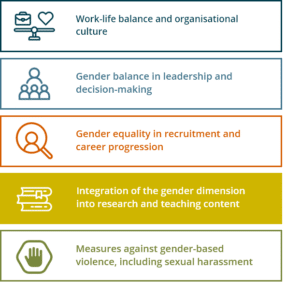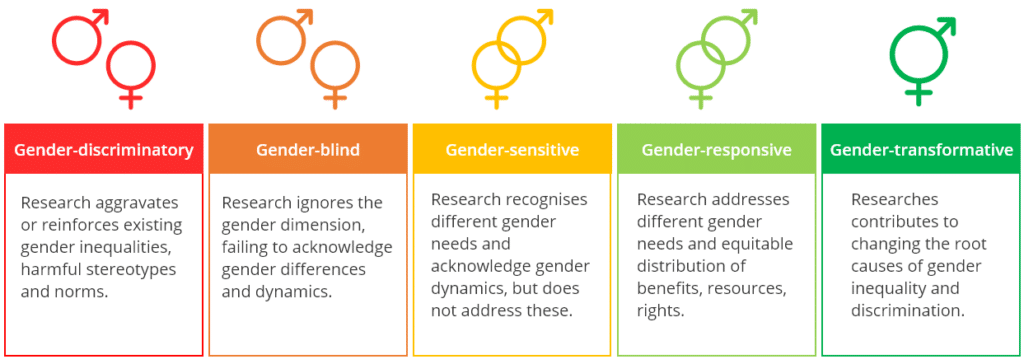Nehem is an important service provider in the field of Diversity, Equity and Inclusion (DEI). Our DEI experts are committed to contribute to SDG 5, and have the knowledge and tools to support organizations in the creation of a gender equal work environment where talent can thrive.
Gender equality is a broad and multi-faceted concept. The European Commission recommends a division into five thematic areas for gender equality in research & innovation. In a series of five articles, we will introduce you to these thematic areas, which we like to call Key Areas of Intervention (KAIs). This article will focus on KAI 4: ‘Integration of the gender dimension into research and teaching content’.

“Making gender and sex analysis integral to research, innovation and teaching content is a powerful way to include a broad range of perspectives and to strive for innovative results of high quality, as well as sound, safe and relevant outcomes and impact.”
SPEAR, 2023
The integration of the gender dimension in research means that gender is part of the research design and systematically controlled for throughout the research process without necessarily being the main focus of analysis. It leads to an in-depth understanding of needs, behaviors and attitudes and enhances the societal relevance of the knowledge, technologies and innovations produced.
Within the research community, the gender dimension has been integrated most widely in the social sciences and humanities. This is in line with the idea that the integration of the gender dimension is only relevant for subjects related to these fields. As EIGE (2022) mentions, conventional research agendas often fail to take into account gender differences and to distinguish different possible impacts related to gender. However, simply put, research that involves people or has an impact on people, also has a relevant gender dimension. A textbook example that can be used to illustrate this can be derived from the car manufacturing industry in the U.S., where women are 73% more likely to sustain serious injuries from a car crash and 17% more likely to die (University of Virginia, 2019). Despite these statistics, crash test regimes only require tests on male-representing dummies – crash-test dummies based on the ’average’ male body. Female crash-test dummies did not exist, even though men and women have clear different physical features i.e. height, size, weight and anatomy (e.g. the presence or absence of breasts).
This full integration can also be referred to as gender mainstreaming: “It involves the integration of a gender perspective into the preparation, design, implementation, monitoring and evaluation of policies, regulatory measures and spending programs, with a view to promoting equality between women and men, and combating discrimination.” (EIGE, 2022). Gender mainstreaming is part of a larger transition towards a diversity curriculum and research policies and practices. It involves a concerted effort to address explicitly the missing content from research/teaching and to shed light on these topics and their omission. In the context of education, gender mainstreaming eliminates harmful gender roles in the classroom and related-workspaces and materials. Committing to the process and steps of gender mainstreaming can therefore effectively address inequality in research and education spaces.
The successful integration of the gender dimension in research and teaching is twofold:
- Investing in equal opportunities for men and women to ensure a gender balance in teams, allowing them to perform better and attract top-level professionals;
- Investing in a gender-responsive approach to research and teaching content to enhance the quality and validity of the content.
Furthermore, the Gender Results Effectiveness Scale (GRES) provides a five-point scale showing different levels of effectiveness, moving from discrimination towards transformation. It reflects the idea that the integration of the gender dimension requires more than simply counting women or men or ensuring that women benefit from research too (UNDP, 2015).

Lastly, questions that help by creating gender-responsive approaches to research and teaching:
- Did you have gender in mind when formulating the research question?
- How do men and women differently relate to the research problem?
- Do case studies in classes include examples of men and women? E.g. female CEOs?
SPEAR (2023). Integration of the gender+ dimension in research, innovation and teaching. SPEAR’s Cycle of Policy Reflection, 4.
EIGE (2022). Gender in research. Gender mainstreaming.
University of Virginia (2019). Study: New cars are safer, but women most likely to suffer injury. Center for Applied Biomechanics.
UNDP (2015). The Gender Results Effectiveness Scale (GRES): A Methodology Guidance Note. Independent evaluation office.
Read more about Diversity, Equity and Inclusion
Nehem helpt bij bedrijfsanalyse en uitvoering MDIEU-projecten
Het ministerie van SZW heeft onlangs een nieuwe aanvraagronde gepubliceerd voor de tijdelijke Maatwerkregeling duurzame inzetbaarheid en eerder uittreden (MDIEU). Organisaties kunnen subsidie aanvragen voor een bedrijfsanalyse (sectoranalyse) of activiteitenplan....
Unieke SWLO-methodiek vermindert uitval van mensen
“Muziek is een universele taal die mensen verbindt. Het Studie- en Werksucces met het Leerorkest (SWLO) leert mensen samen een instrument bespelen waardoor ze 21e-eeuwse vaardigheden ontwikkelen. Dit vermindert hun uitval en stimuleert hen dat ze de regie nemen over...
1% project Petje af
Vanuit het speerpunt maatschappelijk verantwoord ondernemen, hebben de medewerkers van Nehem de mogelijkheid om 1% van hun werktijd te besteden aan een maatschappelijk project. De adviseurs kiezen zelf een thema of organisatie dat past bij hun eigen interesses. In dit...


